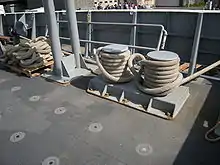
_returns_to_the_operational_side_of_the_Pacific_Submarine_Force_as_she_returns_to_Pearl_Harbor_Naval_Station.jpg.webp)
Bitts are paired vertical wooden or metal posts mounted either aboard a ship or on a wharf, pier or quay. The posts are used to secure mooring lines, ropes, hawsers, or cables.[1] Bitts aboard wooden sailing ships (sometime called cable-bitts) were large vertical timbers mortised into the keel and used as the anchor cable attachment point.[2] Bitts are carefully manufactured and maintained to avoid any sharp edges that might chafe and weaken the mooring lines.[3]
Use
Mooring lines may be laid around the bitts either singly or in a figure-8 pattern with the friction against tension increasing with each successive turn. As a verb bitt means to take another turn increasing the friction to slow or adjust a mooring ship's relative movement.[1]
Mooring fixtures of similar purpose:
References
- 1 2 3 Knight, Austin M. (1937). Modern Seamanship (Tenth ed.). New York: D. Van Nostrand Company. p. 783.
- ↑ Keegan, John (1989). The Price of Admiralty. New York: Viking. p. 276. ISBN 0-670-81416-4.
- ↑ Manning, George Charles (1930). Manual of Naval Architecture. New York: D. Van Nostrand Company. p. 158.
- ↑ Knight, p.788